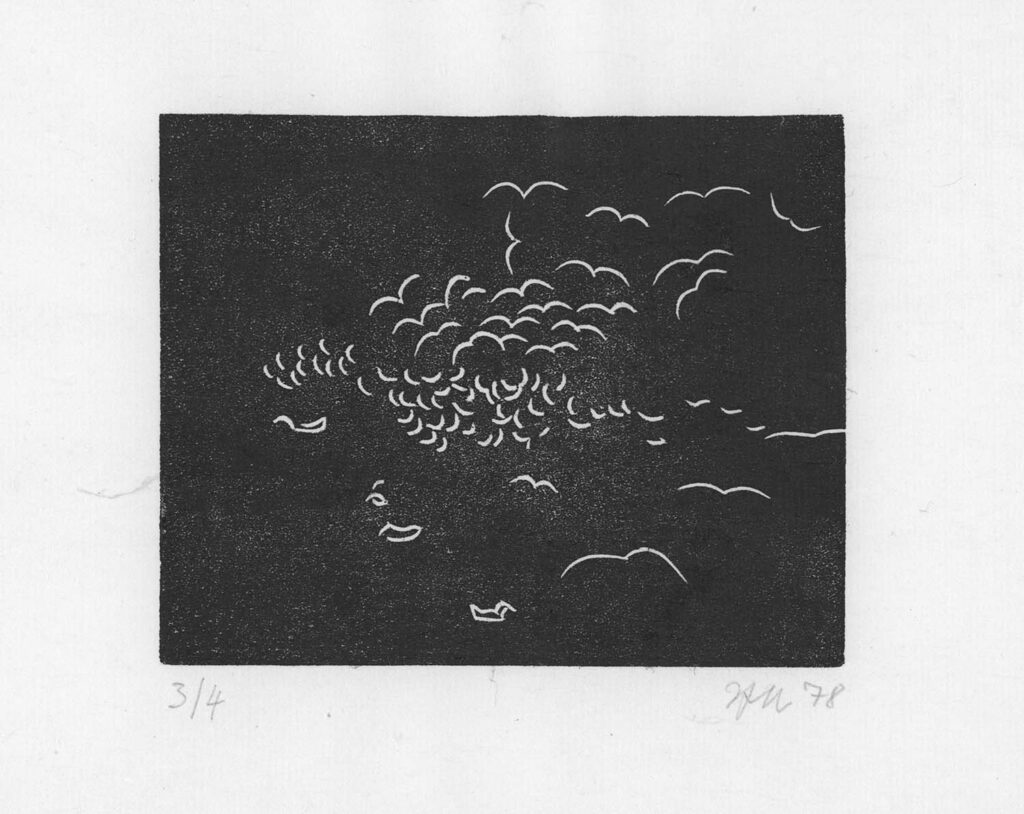The illustrator of Zurich
Naegeli is written on one of the doorbell signs of an apartment building in Zurich’s Kreis 7 district, with people named Schwitters and Arp seemingly living above and below. Is Harald Naegeli cavorting among the descendants of the great Dadaists of the last century? Well, yes. Almost. The artistic greats have been underground for quite a while, and the doorbell signs with their names have been put up for fun – by none other than Harald Naegeli himself. Even at 84, the “Sprayer of Zurich” is still in the mood to paint. As soon as you enter the house of the forefather of street art, you realize that there is much more to the name Naegeli than spray cans and stick figures on the walls. In fact, the student at the School of Arts and Crafts always started out by drawing, his sketchbook his constant companion. “In 1968, I saw how the students used spray cans for slogans. That gave me the idea of doing the same instead of sketching on the walls in my book.” Naegeli got hold of spray cans and made his first attempts at drawing on hidden walls. “At first I sprayed a figure in a backyard, very shyly. Then it was like a kind of dam burst. I got more and more into a frenzy and wanted to cover the whole city with my eyes and figures.” The rest? Is history. Urban history and art history at the same time. Naegeli can undoubtedly be regarded as one of the pioneers of European graffiti culture and played a decisive role in shaping the art scene in Zurich and other European cities. It is no wonder that many believe that Naegeli’s own four walls are also covered in the bold lines of his graffiti figures, spray-painted eyes, flamingos and dancing skeletons. But Naegeli would not be Naegeli if he did not provide a moment of wonder here too. Casa Naegeli shines in sublime white, with small and large-format drawings and collages hanging here and there on the walls or leaning on easels. The color palette is reduced; black is the predominant color alongside the white of the walls, paper and canvases. Graffiti, spray cans, the smell of spray paint? You’ll look in vain for any of that. “I have two sides, if you like. I’m a sprayer – and I’m a bourgeois artist,” is how Harald Naegeli describes himself. “My work is always about a multifaceted examination of space, the interior and the exterior. The exterior space is treated with spray, while various techniques are possible in the interior.” In Naegeli’s studio, a wide variety of works and media really catch the eye. There are the more than 500 sketchbooks in which the artist nimbly records whatever comes under his nose. There are the collages made of black adhesive tape, the felt-tip pen and ink drawings, the oversized primordial clouds. And above all: animals. Again and again, drawings of horses, chickens or dogs flash out from between the pages of the sketchbooks, and here and there an animal can also be seen in the pictures on the walls. Naegeli explains his fascination with animal motifs with a deep connection to the original elements of movement that animals symbolize for him. He describes them as the “origin of drawing”. “Drawing starts from the dot: You make a point, the point is extended, expanded, it becomes a line, the line becomes a surface and the surface becomes space. When drawing, the dots start to move – and become a tree, a person – or an animal, depending on the situation.” It is the movements that fascinate Naegeli – whether impulsive and full of verve, as in the spray-painted Undine, which has been leaning casually against an exterior wall of the German Department at UZH for decades; or whether subtle and almost intimate, as in his animal studies, the small-format landscape drawings or minimalist fantasy figures on paper. It is precisely these movements, the extroversion of drawing in public and the introversion of the drawing process itself, that bring together the inside and outside and thus the apparent opposites in Naegeli’s work. So does the aristocratic title “Sprayer of Zurich” fall short? Perhaps. At the same time, it leaves room for the new, the unexpected and the surprising. Because even though Naegeli now only dreams of spraying – his health no longer allows him to go around the houses with a spray can – he never tires of reaching for his sketchpad every day to draw, paint and collage. And to show how much artist he still is. I wonder what Mr. Schwitters and Mr. Arp would say? Perhaps it wouldn’t be a bad idea to ring the bell above Naegeli’s name the next time you visit… Sprayer, draughtsman, animal lover, Musée fan, necromancer – Harald Naegeli’s possible nicknames are as varied as his work. As part of Naegeli Month in June, a charity auction will be held at the Musée from June 6 to 26. Selected works by Harald Naegeli will be auctioned off to the highest bidder in the museum store, which is open to the public. Half of the proceeds will go to Hof Narr, a sanctuary for animals in Hinteregg, and half to the Musée. The Musée Visionnaire is – as the name suggests – a visionary institution that is also supported by many volunteers. It is a museum that I like very much, better than these established commercial institutions. And because the state and the city don’t provide any support, part of the proceeds from the auction will go to the Musée.
(Harald Naegeli, April 2024)






